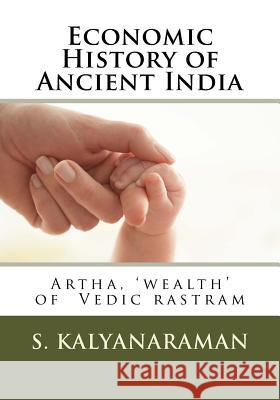Economic History of Ancient India: Artha, 'wealth' of Vedic rastram » książka
Economic History of Ancient India: Artha, 'wealth' of Vedic rastram
ISBN-13: 9781541275928 / Angielski / Miękka / 2016 / 378 str.
This volume is a sequel to the successful decipherment of Harappa Script Corpora as metalwork catalogues. Rigveda which is the oldest document of the civilization of India contains unambiguous indicators related to the idea of rastram which is, in effect, a pathway for wealth creation for the commonwealth of people, ensuring abhyudayam for all and environment including flora and fauna. While attempts have been made to reconstruct the Economic History of the World (pace Angus Maddison) from 1 CE, there have been no major efforts to rewrite the Economic History of the millennia Before Common Era, say, from the days of the Rigveda dated ca. 8th millennium BCE. This monograph is a preliminary attempt at building upon the idea of rastram as the movement of wealths across communities as commonwealths and at narrating historical evolution of sreni as a social corporate form. In this attempt, significant leads are provided by the decipherment of the Harappa Script Corpora; in particular, the unique ceramic stoneware responsibility badges with Harappa Script which describe the assignment of specific functions to participants in a guild. The treasurehouse of ancient texts of India provide the literary framework to define the weltanschauung of the people of the rastram. Archaeological discoveries, sculptures and iconography help validate this framework chronologically in an extensive contact area of Hindu Veda civilization that travelled along a maritime Tin Route stretching from Hanoi (Vietnam) to Haifa (Israel) through Eurasia, about two millennia before the dawn of the Silk Road. Given the complex nature of the task, this volume is but a continuum of Harappa Script primer --Cryptography for metalwork trade (2016) and will continue to be a work in progress as multi-disciplinary researchers report their findings to enable us to narrate the History and Culture of India. with fidelity. In a nutshell, this is an extraordinary history governed by the primordial value of dharma-dhamma as performance of one's responsibilities for abhyudayam and nihsreyas-a veritable Pilgrim's Progress in an enquiry from Being to Becoming, uniting the atman with the paramatman. Economic history of Ancient India is a story of artha in civilization - artha as defined in Kautilya's Arthasastra: "The subsistence of mankind is termed artha, wealth; the earth which contains mankind is also termed artha, wealth; that science which treats of the means of acquiring and maintaining the earth is Arthasastra, Science of Polity." (R. Shamasastry, tr., Kautilya's Arthasastra). The weltanschauung of Meluhha people who encrypted Harappa Script is expressed in a precise, unambiguous example of Harappa Script cipher: kole.l 'temple' rebus kole.l 'smithy, forge' (Kota language). This is an affirmation of a value system which governed the life-activities of Bharatam Janam that 'Work is worship'. This is the principal lesson learnt from the Economic History of Ancient India. Metalwork is one form of creating wealth of a rastram. (RV 10.125) atma is devata of the sukta (RV 10.125); Soma is atma of yajna. Creation of wealth is dharma and a positive affirmation of one's life activity consistent with one's proclivities and competence. kAyakave kailAsa -- Basava. The idiom means: work is worship. medha also has the semantics of: 'dhanam, wealth and yajna'.
Zawartość książki może nie spełniać oczekiwań – reklamacje nie obejmują treści, która mogła nie być redakcyjnie ani merytorycznie opracowana.











